9 October 2018
The annual parade takes place every 9 October. It’s partly a civic walk-by of local dignitaries but also a march of all the political parties of various persuasions. It’s also S. Dionisio day- an equivalent to Valentines Day.
9 October 2018
The annual parade takes place every 9 October. It’s partly a civic walk-by of local dignitaries but also a march of all the political parties of various persuasions. It’s also S. Dionisio day- an equivalent to Valentines Day.
Week 1 1-7 October

Ready to go
MONDAY. I boarded the Valencia-bound bus at 8.35am. As I’m waiting, a woman points to my back-pack and says “Bien Camino”; she walked the Camino de Santiago de Compostela from A Coruña two years ago. Perhaps we were in Santiago at the same time; that’s a nice thought...
The bus is packed; the journey to Valencia takes 90 minutes and then a 5 minute walk to the flat from the bus station. My new home is a large, airy modern flat on the 8th floor; the sitting room over looks the old Turia river bed, now a popular and verdant park.

Between two worlds. The sitting room overlooks Turia Park and my bedroom a typical Valencian neighbourhood with primary school and church in the foreground.
My bed room looks north and has views of the concrete of modern Valencia with a reassuring glimpse of the Serranos mountains on the distant horizon.
TUESDAY I happen to be on a bus that followed the diverted River Turia for several kilometres. It’s a vast, empty concrete channel hemmed on both sides by crash barriers, motorways and spanned by numerous bridges; nature banished and subjugated.

Filtro de agua
WEDNESDAY The tap water in Valencia makes undrinkable tea; an unappealing brown scum floats on the top. So my first outing is to buy a Brita water-filter jug at my local ‘El Corte Inglese’ (tr. ‘The English Cut’- as in tailoring; a department store that bears an uncanny similarity to John Lewis.) I also buy three cheap white mugs, as it takes too long to drink tea out of tiny espresso cups. I’m intrigued that my first purchases here are vessels for purifying water and drinking.

Compré tres tazas blancas
My neighbours arrive from London early afternoon and we have a few days of tourism ahead.

The Valencian region is famous for its rice dishes; paella and its pasta cousin ‘fideua’ are served in the traditional wide flat pans as a communal dish.
We eat lunch at a restaurant without tourists, hidden in a side street behind closed doors; a recommendation from a foodie local. A delicious ‘Menu Del Dia’ which included paella.

The Central Market
The Central Market is a marvel; hundreds of stalls selling spices, hams, whole chickens with their heads on, pulses, fish and vegetables. I finally discover what the orange fungi are called: rebollon. We were tempted by rosemary-coated sheep’s cheese, knobbly Valencian tomatoes, bread and white grapes.

We also visited the Llotja de la Seda (Silk Exchange). A stupendous piece of Gothic (1482 -1548) stone masonry with an extraordinary hall of tall twisted columns and a shady courtyard with orange-trees. The wealth of medieval Valencia was built on the silk trade and this hall was the trading floor; wealth built on those bales of beautiful Crimson clothe; kermes dyed.
DAY 30 Sunday 30 September

Breakfast in the Plaza Mayor
Final packing and off for breakfast in the Plaza Mayor; the usual tostada com tomate.
The Tourist Information Office is open at weekends and there are maps of several longer walks around Chelva to explore in November; the weather will be just right then. I discover that I can walk to the Rio Turia via something that translates a Death Pass. Mmmm.

There are several tiny hermitas dedicated the the Virgin; all are locked.
I walk north out of Chelva and discover a whole new part of town. Here are tiny whitewashed chapels dedicated to various Virgins, the bull ring, cemeteries, the football club and best of all, el Fuente de “La Gitana”.

The bull ring is on the northern outskirts of Chelva; the Torrecilla is visible to the right.
There are shady, pollarded plane trees and picnic tables and I sit alone surrounded by the sound of numerous waterspouts, gushing basins and cascades, while leaf-shadows play on the white walls. Heaven; the Naiads are smiling.

El Fuente de “La Gitana” (Gypsy)
The sound of running water fills the valley.
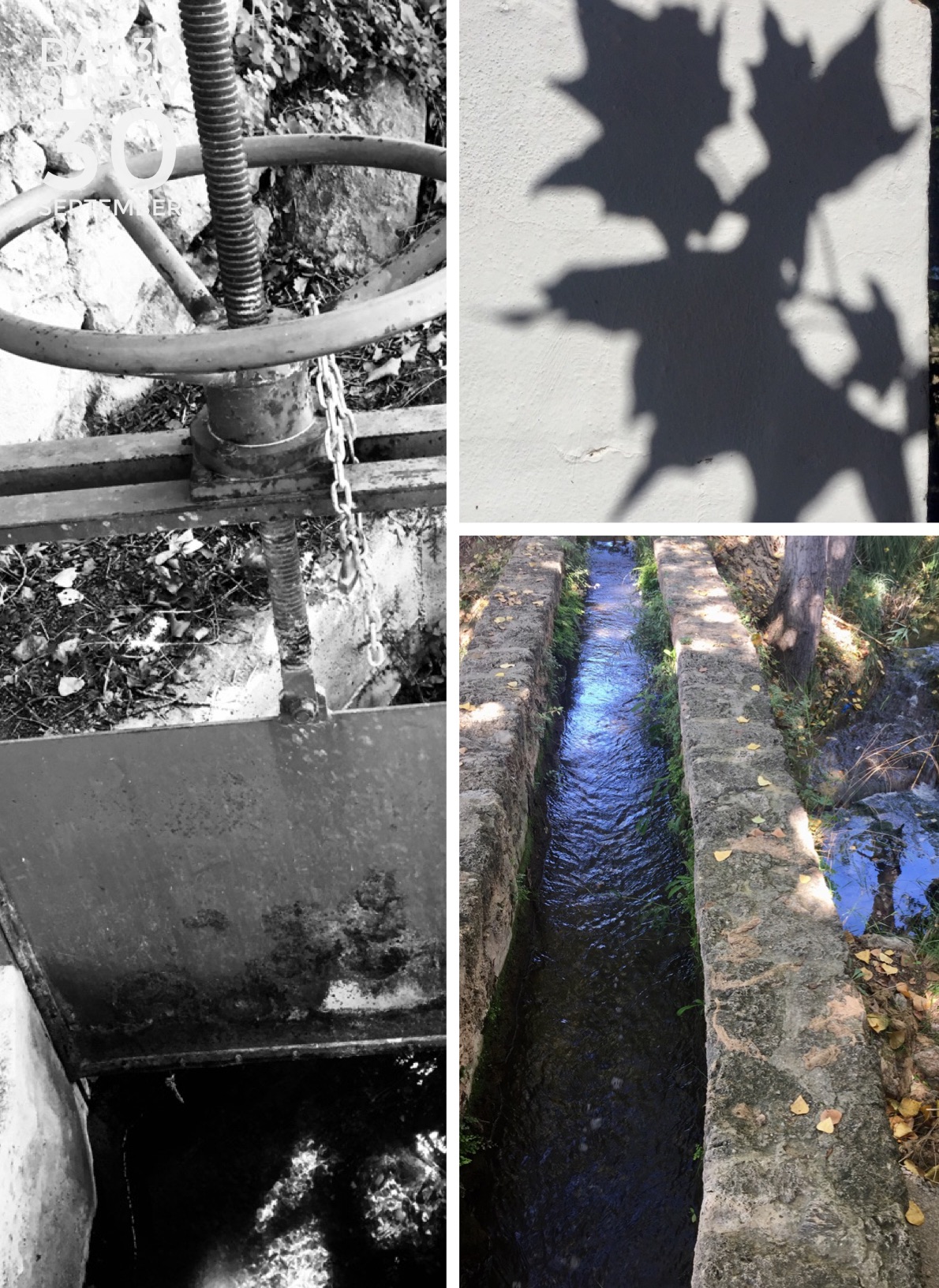
El Fuente de “La Gitana”; sluicegate, channel and shadows.
I pass an interesting piece of irrigation infrastructure; one channel splits into two with a carved stone plaque showing the irrigation system around Chelva- it’s very extensive.

The engraved stone map of Chelva’s extensive irrigation system and a splitter channel.
I walked back to town for lunch; Chelva is bustling; people sitting in bars, hikers, wandering families and the only restaurant is full; several bands of bikers rumble by. I have chipporones (baby squid), tortilla and a beer outside a bar.
The bus leaves Chelva for Valencia at 5.10pm, so I have the day to do nothing.

Baby squid fried in olive oil.
BUT it didn’t, because it is now running on the ‘winter’ timetable and it left at 4pm; I wasn’t the only one waiting in vain! So I have an extra night here and will catch the 8.35am tomorrow.... I’m obviously meant to be here for the whole month.

Surprised by the ‘best till last’- El Fuente de “La Gitana”.
DAY 29 Saturday 29 September
Packing up the house and focusing on moving to Valencia has been a process of dismantling and packing away. The studio walls are blank and white again, the paint splattered polythene and cardboard folded away.

Studio dismantled... for now.
I’m looking forward to some Valencia city vibes again, but happy knowing that I’m returning to Chelva in a month’s time.
I’m wondering about making videos while I’m there as I won’t have a studio, but I shall be living just a few yards away from the ‘dry’ Turia riverbed.
I’m also hoping to enrol in a language course; there’s a college just a few minutes walk from the flat.

Sluice-gate, River Chelva
I have joined the ranks of ‘las ancianas chelvanas’ (old ladies) and am now the proud owner of ‘un carrito de la compra’ - a shopping trolley.
Having unsuccessfully toured the shops again in search of a nice cabin-sized suitcase, I decided a shopping trolley would be more useful in Valencia Central Market!

The beautiful Ruta del Agua
After coffee with the anglophones in the Plaza Major, I walk along the River to the Playeta. There are people swimming, but dipping in my toes is enough for me- it’s freezing! Then home to pack my trolley!
DAY 28 Friday 28 September
The gradual process of ending my residency begun today; I felt I wanted to record the space before it is dismantled.
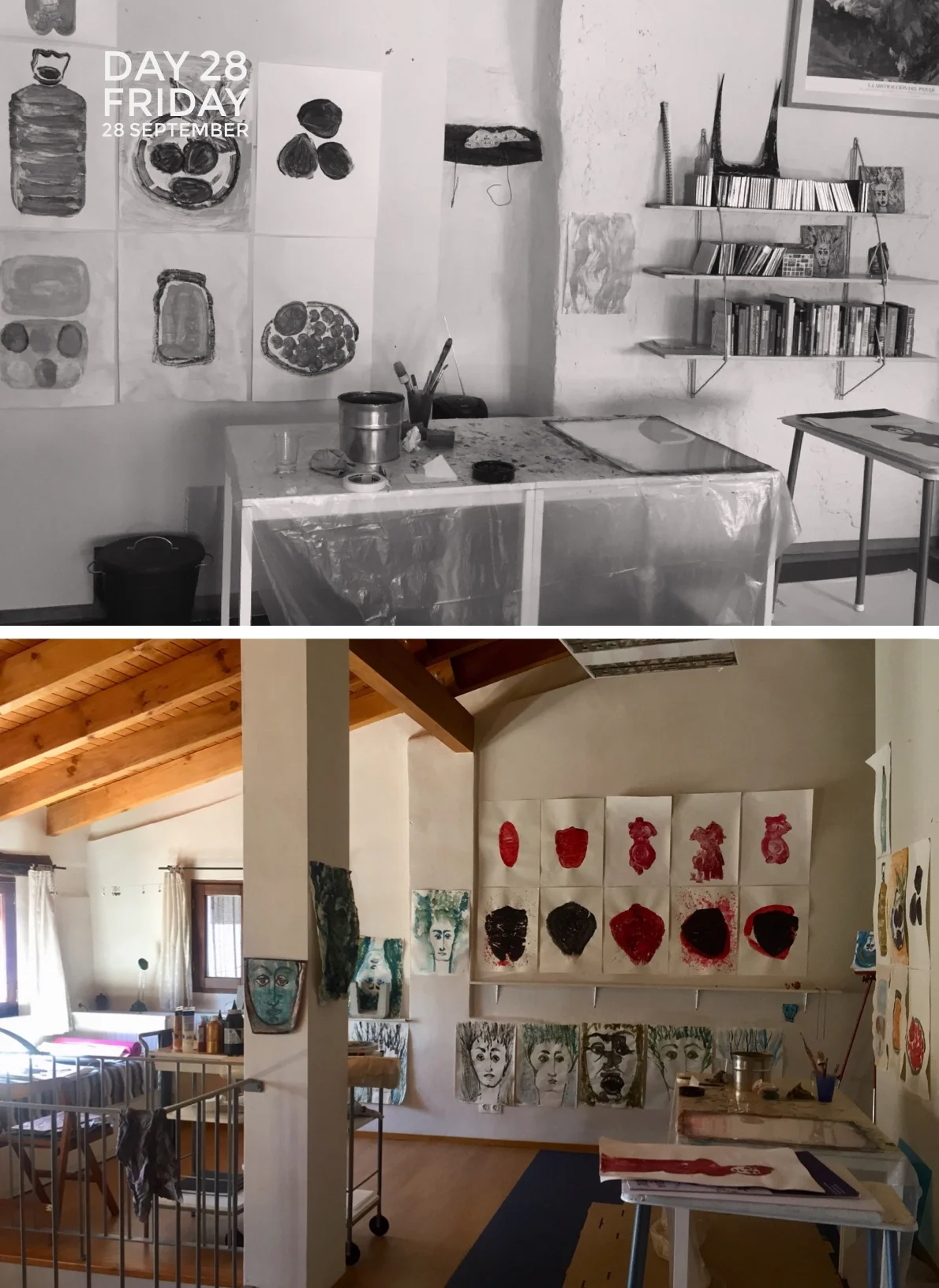
I stopped making prints a few years ago, but have re-engaged with the process during this residency. I enjoy the rapid, surprise and uncontrolled aspect of mono-prints.

The Crimson Mothers and Naiads have both developed from my engagement with this Place: Chelva.
My sister sent me a photo of an Ancient Greek torso; it has concluded my investigations into the Kermes scale-insects and the manufacturing of Crimson dye....
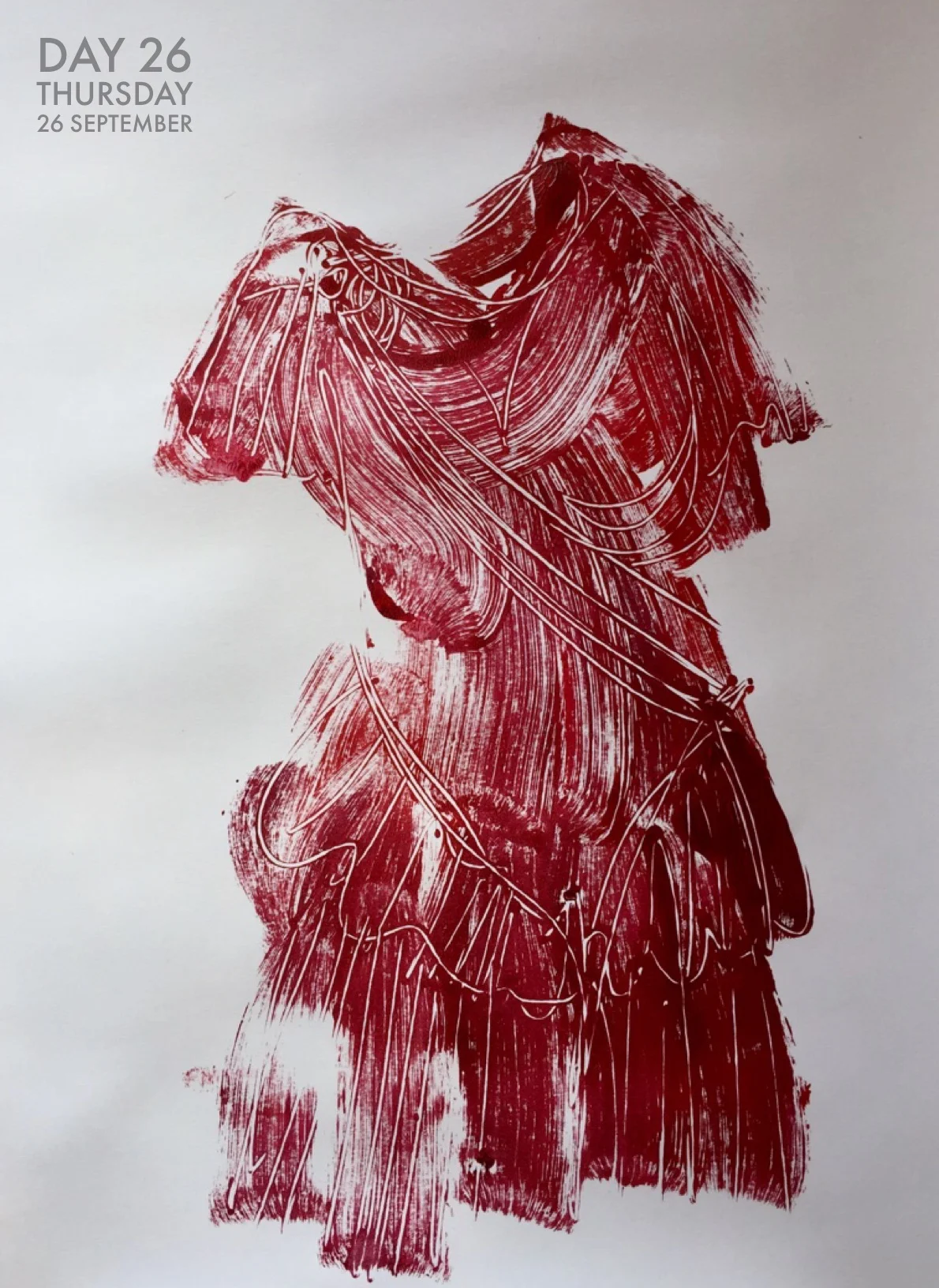
Print based on a statue of an Ancient Greek female torso: crimson, limbless and immobile.
DAY 27 Thursday 27 September
My sister sent me a photograph of a beautiful marble female torso in the Archaeological Museum in Athens; she is headless, limbless and immobile.

Crimson Mother 2. Limbless and immobile. Mono prints on paper.
It has set me off in a new direction with the ‘Madres Carmesi’, there now seems to be a link between of the watery, blue Naiad heads and the earthy, crimson Mothers torsos.

Crimson Mother 3
In the afternoon I walked along the River Chelva to La Luz, which is a ruined water turbine electricity generating station set in a deep ravine.

La Luz- a ruined water turbine electricity generating plant on the Chelva River. 1952-1981.
Spanish geology is dramatic and raw, you can see massive mudslides in the cliff walls and huge boulders litter the river valley floor; the landscape displays the manner of its making.

The ravine walls are massive mudslides. Local flora including Kermes Oak; showing the thorny acorns and holly-like leaves.
It was a steep climb out of the valley with dramatic views to the mountains and some interesting flora; I came across more Kermes Oaks, but no scale-insects were in residence. The view back to Chelva is a delight.

View across the valley to Chelva, a steep climb out of the ravine and views to the mountains.
Lots of new plants to discover. Asparagus (bottom left) grows wild here and you can harvest it in spring. Prickly pears look delicious.
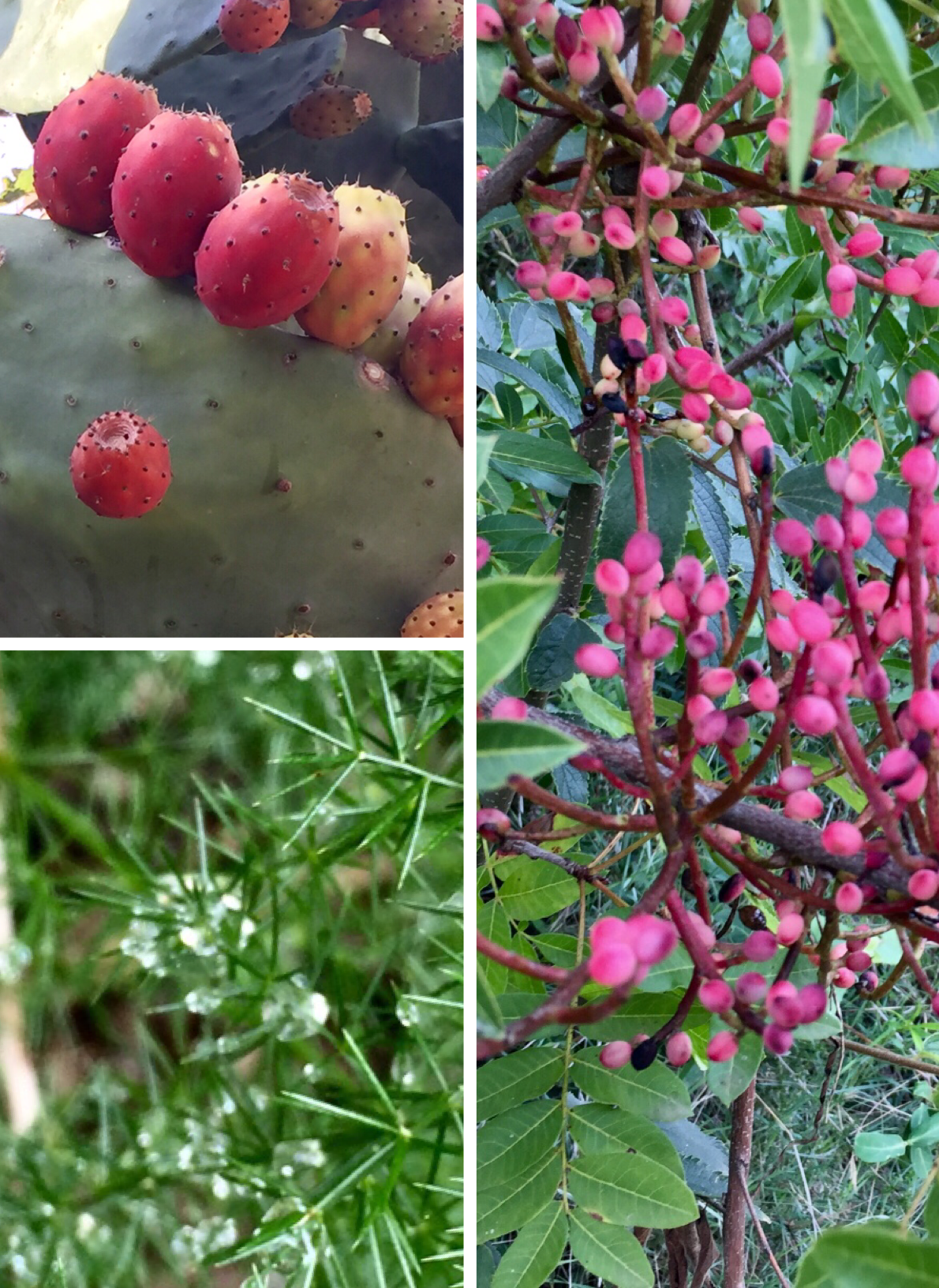
Local flora
I bought supper from the local fishmonger (there are two in the town!). Baby hake - very delicious pan-fried with garden red pepper and mushrooms.

Pan fried hake with homegrown peppers.
DAY 26 Wednesday 26 September
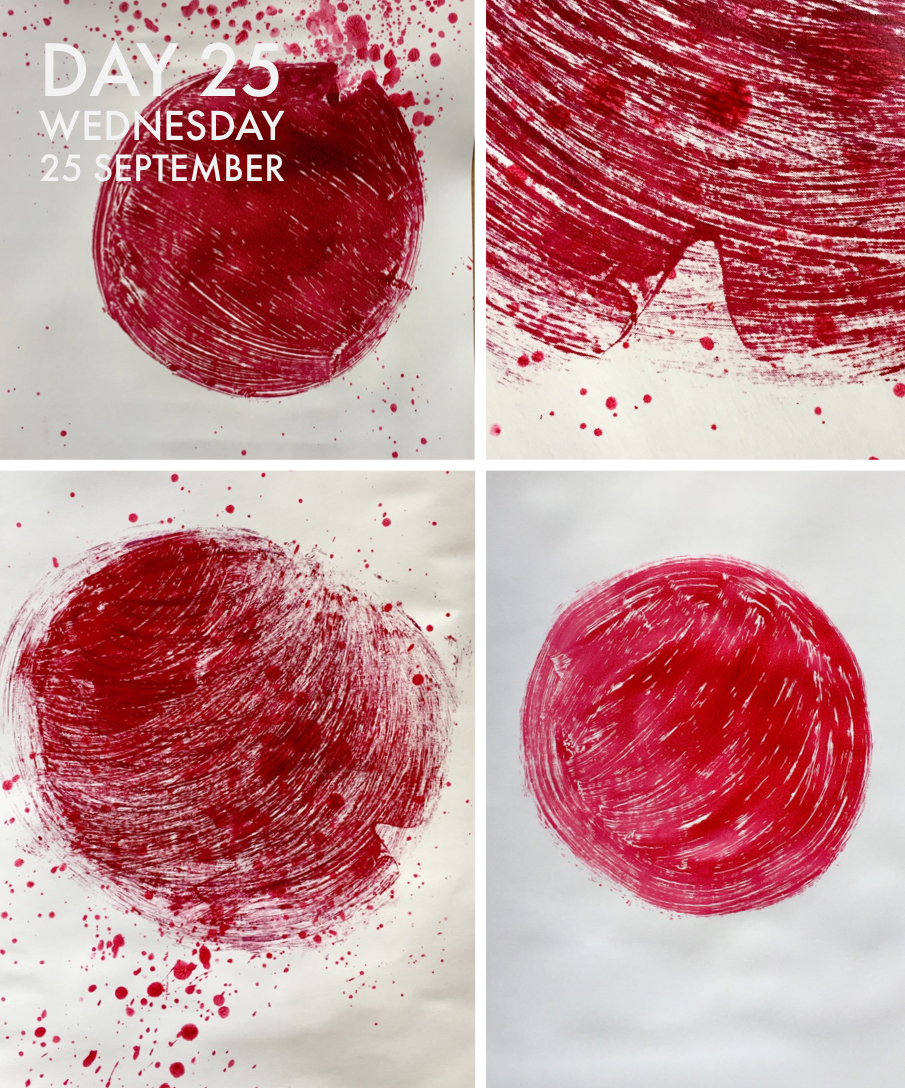
Various Madres Carmesí. Mono prints on paper.
More Red Mothers- limbless and immobile.
Followed by a Yoga class in the nearby town of Villar in the evening, which is neither limbless or immobile. The Yorkshire woman who I met on the bus on my way to Chelva almost a month ago, is also in the class!
DAY 25 Tuesday 25 September

Olive Oil Can (stainless steel).
A trip to the Chino (Euro Shop) to look for a small suitcase to take to Valencia this morning. Rather grim choices for €25, so I postponed and bought an olive oil canister instead. It cost €2.75 and is now filled with delicious organic olive oil from Ricardo’s olive grove.
Every day around 12.30pm the Town Hall announces notices over a tannoy from the Plaza Mayor. They are proceeded by music and apart from one or two words I have no idea what they are saying. This is an example from earlier in the month, so whatever was being announced - I’ve missed it.
DAY 24 Monday 24 September

‘Madres Carmesí’. Mono prints on paper
I’m never sure when a series is finished, but there is space for three more ‘Mothers’ on the studio wall. There’s something interesting about 100,000 squashed pregnant mothers making 1 kilo of one of the most valuable commodities of the ancient and medieval world; the red dye Kermes from which we derive the words Crimson and Carmine. It was used by the Roman as tribute and accepted as rent.

This photo shows a mature female Kermes scale insect. The dye was called ‘grain’ because it was thought to be of vegetable origin.
I learnt today that mature female scale insects are limbless and immobile, feeding on the sap of their host species, the Kermes Oak, which I spotted on one of my walks. In May/June they are gall-like, 7mm diameter, almost spherical. Thousands of tiny red ‘crawlers’ swarm out through a small orifice near the point of attachment of the Mother. Some species of scale insect display parthenogenesis ie. virgin birth. Excellent.

Three Naiads
I practiced yoga for an hour and made three more Naiads- they are becoming weirder- good!
DAY 23 Sunday 23 September
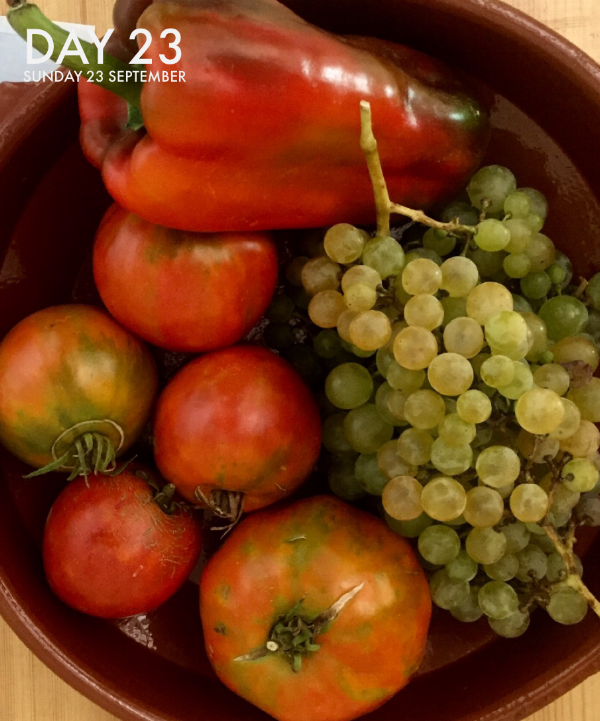
Bakeries open for just a few hours on Sundays and I’m never sure which or where - I found a new one today and bought a lovely crusty stick. A late breakfast in the Plaza Mayor; coffee con leche y tostada con tomate; definitely my favourite Spanish breakfast. As I was leaving I spotted a couple of Brits and went over for a chat.
This afternoon collected my homegrown organic vegetables. The gardener, Ana has a WhatsApp group and advertises her produce weekly; then you go and collect it from her garage cum shop. Great idea!
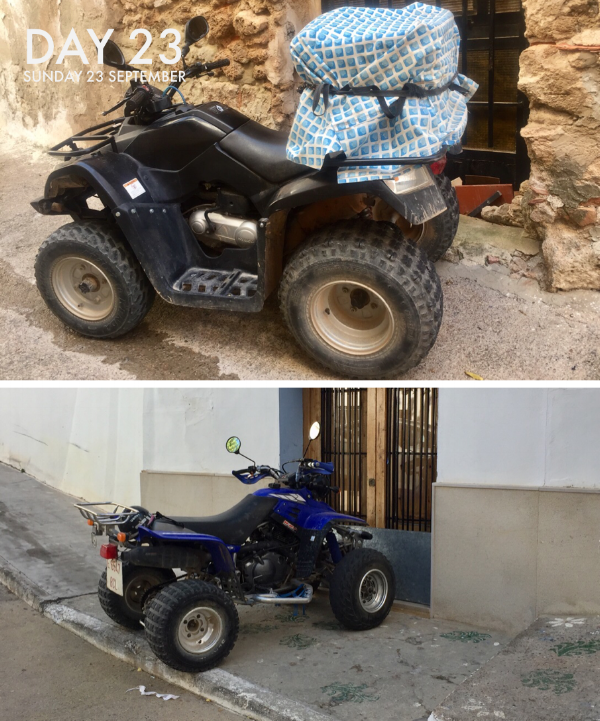
I quite fancy one of these- it would turn a few heads though!
Lots of men in the town have quad bikes which they park outside their houses- usually adapted with boxes to carry produce. The old men have ride-on rotavators with trailers, but I haven’t seen any women riding them... yet.

Naiad. Mono-print on paper.
DAY 22 Saturday 22 September
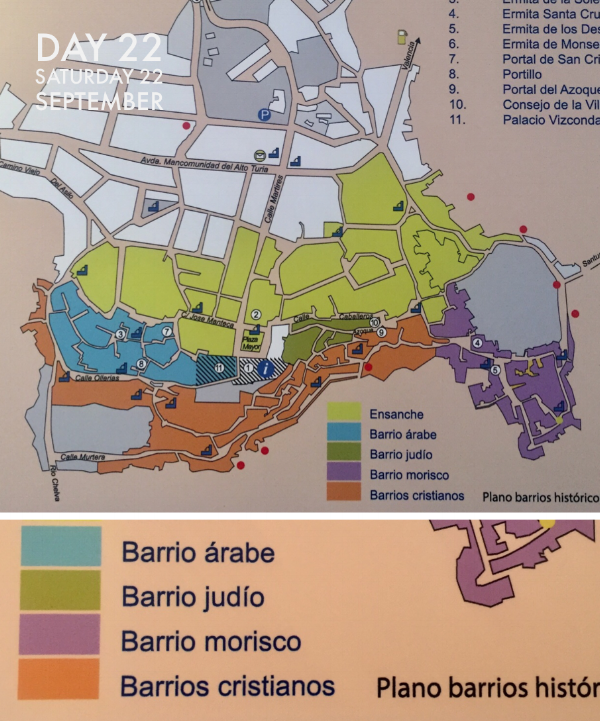
Map showing the various cultural quarters of Chelva (barrios). An amazing number for such a small place.
Every Saturday the Archeological Museum offers different walking tours; this week was the cultural quarters (barrios) of the Chelva. Just three of us plus the guide assembled at 10am and set off for a two hour walk around the Moorish (North African Arab) Christian, Jewish and Arab (Muslim residents re-settled outside the city walls) quarters.

The museum is small, but gives a good account of the different cultures passing through Chelva; starting with prehistoric cave dwellers with flint arrows by the Chelva River, the Ibericans who spoke a non Proto-Indo European language akin to Basque and then the Romans, Moors and Christians and Jews; only the street patterns seem to remain from previous inhabitants and the irrigation system. I also leant that the Roman aqueduct was not built by slaves, but by professionals.
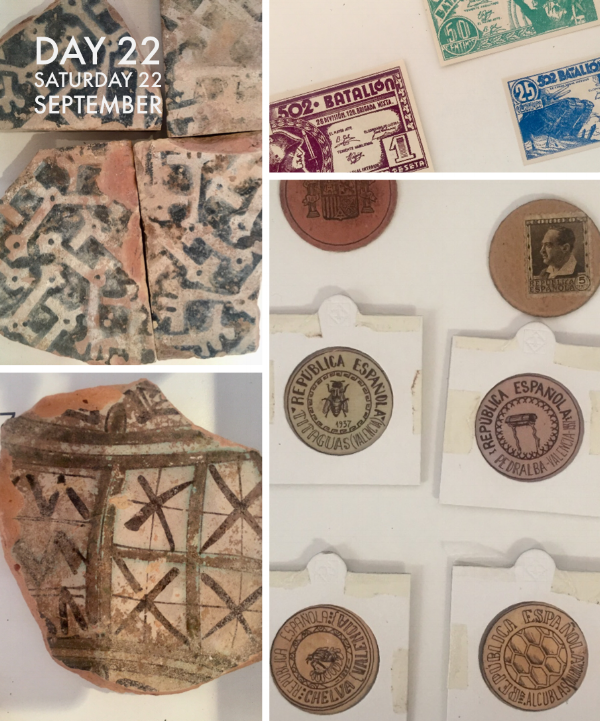
Two pieces of Arab influenced pottery caught my eye. The images on the right are token money used during the Civil War.
The final case shows artefacts from the Civil War, including local paper coins/notes which each town issued, because the official currency was used by the government to pay for troops and armaments.

Hand cooked crisps on the snack stall, delicious olives and pickles and wild fungi. People buy them in kilos- I’m not sure what they do with so many!
Saturday is also market day and I buy olives, fruit and more ‘ravellanos ‘? mushrooms, which I take home and cook straight away. The old lady selling them sits on a crate with two baskets full and she sells me a kilo! They are pale orange with green bruises but turn red when cut, but simmer down to an innocuous brown when cooked; slightly woody and chewy. I don’t think I’ll rush out and buy more.

Typical street planting
After siesta I go for a cup of tea with an Argentinian woman and her Basque husband who also live in the Arrabal district; we eat a selection of delicious homemade jams on biscuits.
DAY 21 Friday 21 September

Limones, patatas, pimientos de Padron and lechuga.
I shop here nearly everyday - food doesn’t keep fresh for long- perhaps it’s the heat. Fruit and vegetables are tasty and cheap, but fish and cheese seem to be more expensive. Lemons are sold by weight.

Potatoes baked with lemon, garlic and red peppers followed by greengages.
I return to the ‘Kindness of Strangers’ and ‘Naiads’ series today; the new Ox-ear Hair brush has a nice loose, watery quality.
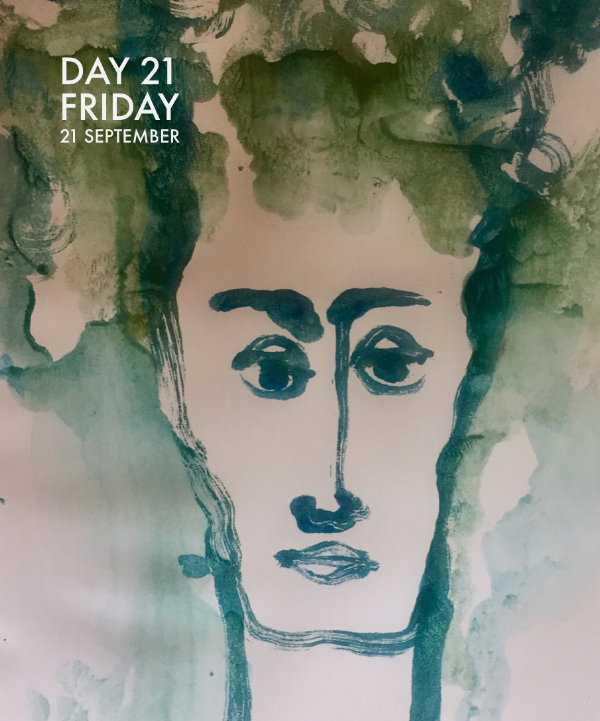
The bottle contains water from a spring about a mile away; el Fuente de Berra. I walked there and a small boy took my plastic bottle to fill it - a precious memory.

Agua Del Fuente de Berra. Mono print on paper.
I drank the water with lunch; lemon baked potatoes with fresh mackerel.
DAY 20 Thursday 20 September

A new bar to add to my choice of watering holes- there’s a few!
The wonders of technology- an hour’s FaceTime conversation this morning and then out for a cold beer in a nice little bar; it’s too hot for coffee. I chat on the phone with another English friend and realise how precious it is to keep connected and share experiences. But there’s still something about the Internet that’s not good for the soul...
Today I find the towns three recycling bins behind the Parish church- good to know.
Delicious baked lemon chicken with potatoes for supper, with new friends under the trees.
DAY 19 Wednesday 19 September
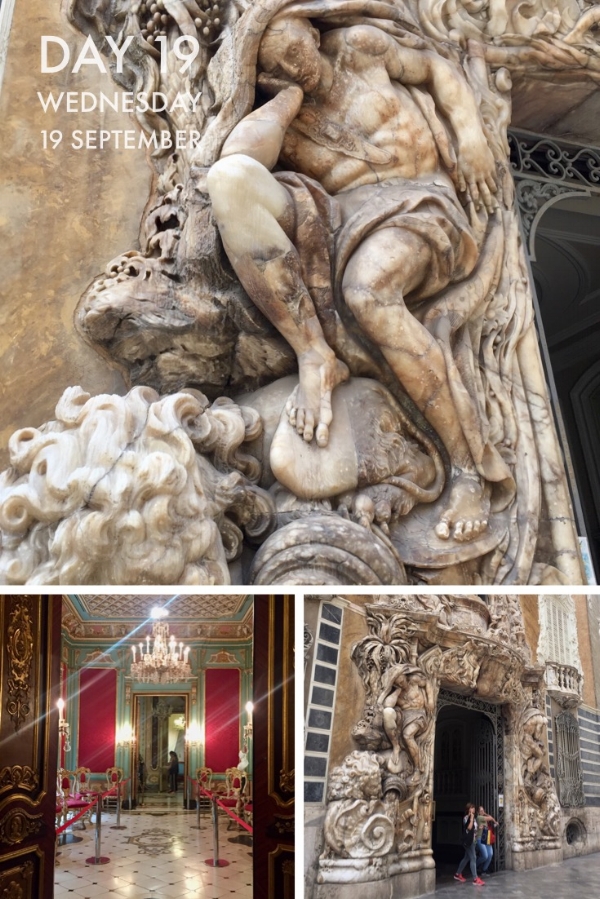
The Ceramics Museum is housed in the remarkable Palacio del Marques de Dos Aguas.which has a spectacular carved alabaster facade and lovely crimson and jade coloured interiors.
Arrabal neighbours with two daughters living in Valencia gave me lift to Valencia and back today. We drove the route I came on the bus 19 days ago, without the detours and stops enroute; Lliria I discover is quite a large town. The journey takes an hour by car.
I’ve have researched Wikipedia and learnt a little of Valencia’s history. It was founded as a Roman colony 2500 years ago for retired soldiers and was called “Valentia” meaning brave, but it’s hay-day was C15th when it’s wealth was generated by banking and the silk trade- until Venice took over! Today Valencia is the third biggest metropolitan area in Spain and the fifth busiest port in Europe; it has a population of 1.7-2.5 million. So there we are.
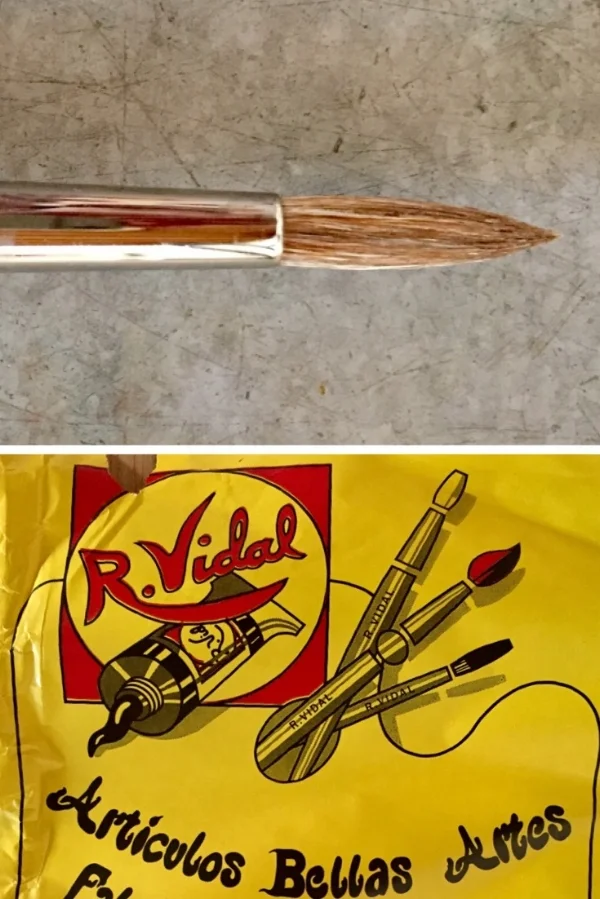
R. Vidal is the Art shop in Valencia and everything comes wrapped in nice yellow paper parcels. I bought paper and a Ox-ear Hair brush - a Spanish speciality perhaps?
They drop me in an area called Benimaclet: a modern suburb of tight streets and flats and I walk to the bus station from there; then to the art supply shop near one of the old city gates; the Torres de Serranos. I’ve bought enough paper to keep me busy for a while.
I bought a brush made of ox-ear hair... we’ll see how that works, but I couldn’t resist its provenance!
A beer, tapas and lunch with friends who have a lovely flat in the Old Town. Then a visit to the ceramics museum housed in the wonderful, alabaster fronted Palacio del Marques de Dos Aguas.

I love the quality of these drawings on ceramics and the particular palette of colours.
I was keen to revisit the Arab influenced Majolica-tin glazed ware which I thought might inform my prints.
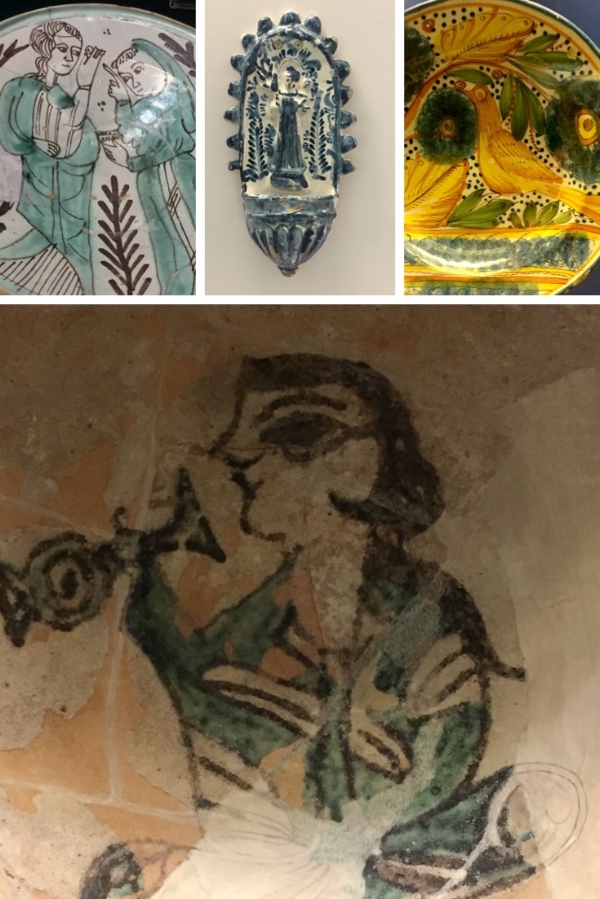
It’s a long walk back to Benimaclet and I get lost in the maze of small streets, but eventually find the place thanks to mobile data. We return via the Lidl supermarket in Lliria and then home to the narrow, winding streets and whitewashed houses of Chelva - another world!
DAY 18 Tuesday 18 September
Today was one of those days when the computer steals your life, but at least I’ve edited this video entitled SED (Thirst). It shows Ben, opening the irrigation gate to water his parched allotment (campo). A wonderful experience; a simple but profound delight.
DAY 17 Monday 17 September

• Everything comes in plastic bags unless you say ‘¡no plastico!’ But the baker did give me a nice piece of greaseproof paper when I asked.
• The local red wines are very strong and delicious! This label shows the Peña Cortada Viaducto.
• Quite a few houses have rows of bottles or water containers in front of gates and doors. I think they are mainly empty or to unoccupied properties and I wondered why? I asked a neighbour; apparently it’s to stop dogs peeing in the corners!
DAY 16 Sunday 16 September

A locust on the window screen.
There’s a very scary looking locust on one of the window screens this morning.

The Old Mosque is a lovely space and I’m wondering about making an installation there?
A bright sunny day and a friend informs me that the water to his allotment (campo) is running today and he is planning to irrigate his plot. It is a very simple mechanism but profoundly wonderful process to see the sluice gate being opened and water spill from the pipes onto the parched ground.
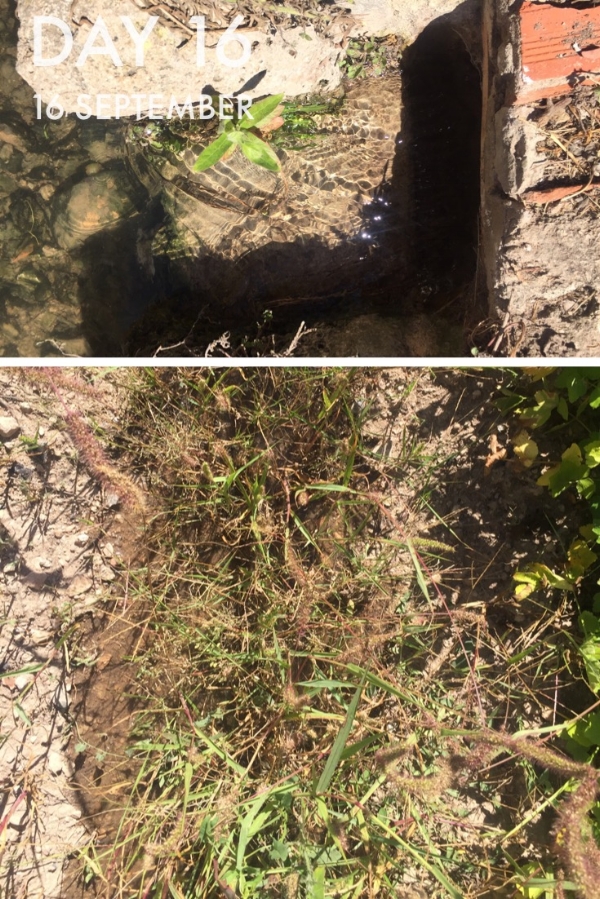
Watering the vegetable garden
En route he borrows the key to show me the inside if the Old Mosque; (La mezquita) it’s a lovely space.

Gate Keeper 3. Mono-print on cardboard and plaster.
I decide to walk to the Fuente de Berra which I couldn’t find on my last walk.

The Shepherd, an ancient olive tree by a cross roads and collecting water at the Fuente de Berra.
On my way I watch an old shepherd separate the ram from his flock and then lead them down the road to graze in the fields under the olives- all rather archetypal.
Apparently lots of people drive to the spring from town to collect their drinking water. It’s on the other side of the Chelva River down a dirt road, high up amongst the olive groves - below the level of the road. It’s very understated; it trickles slowly and silently from a low brown spout. I find it because a man and his young son have parked and are collecting several large canisters of water.
I sit down to wait my turn with my small 0.75l bottle and the little boy comes over, takes it and gives it to his father to fill. How lovely is that.
I return home with my bottle of fresh spring-water and a few figs from a ruined-cottage garden.

Water from the Fuente de Berra
I buy eggs from the old man up the lane and a few local toadstools, but when I get them home they look too poisonous and I don’t have the courage to eat them!

Fresh eggs, rovanalles? fungi and a nice glass of wine in the garden.
Saturday 15th September 2018

The grapes here are delicious; I bought this homegrown bunch from an old lady sitting on the pavement surrounded by a few plastic crates of tomatoes and green beans.
Market day today so I walked up to the Plaza Major. It was quite quiet, but I bought my fruit and vegetables and then a trip to the supermarket for household stuff.
There was quite a gathering of Brits outside the plaza cafe plus an Argentinian who grew up in London and a recent arrival from Quebec. Cafe con leche all round! It poured with rain but stopped after a few minutes and remained dry for the rest of the day.

Sketches for Gate-Keepers. Mono prints on corrugated cardboard and scrap paper.
I’ve run out of paper and am now using the corrugated cardboard covering the studio floor. I’ve applied a layer of fibre reinforced wall-filler! I’m hoping for a sort of fresco effect... mmm. Sounds unlikely. I’ve start to experiment using a Majolica-ware palette.
DAY 14 14 September 2018

Wash Day
I’ve always wanted to hang my washing on one of those frames outside windows; you see them all over the Mediterranean. Well, now I have one. They are the antithesis of tumbler dryers- the washing bakes dry in full public view, and comes in smelling of sunshine.

Channel and print
I’m not sure what to make of today’s work, I tried making prints informed by the dimensions to the sluice gate.
A friend sent me a quote about being given ‘upper and lower waters’ and I’m wondering about that. It’s strange that I haven’t seen wells here?

Upper and Lower Gates. Mono prints on black paper.
DAY 13 13 September 2018
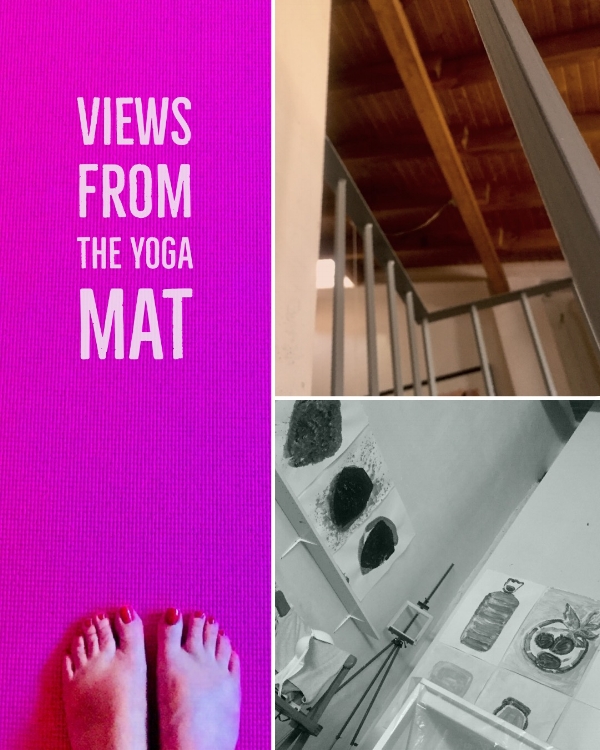
Now I have a yoga mat there are no excuses!
When it gets cool I explore the other end of the riverside walk: la ruta del agua. Ruined mills, a lovely green, fast flowing river, an old medieval bridge, a waterfall, caves and something called La Luz- but I didn’t find out what! I’ll have to go back another time... it’s perfect place for an evening stroll.
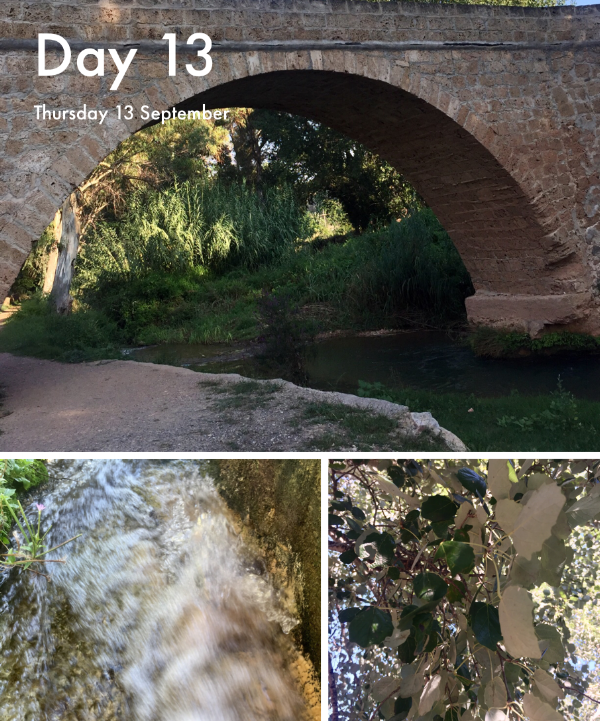
La ruta del agua
The figs trees perfume the air and I pick a few for supper.

Rose hips and a small waterfall
A really lovely circular walk with a steep flight of steps back up into town.

Looking back to town from the other side of the Chelva valley and a view of the river.